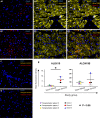Hypoxic cardiac fibroblasts from failing human hearts decrease cardiomyocyte beating frequency in an ALOX15 dependent manner
- PMID: 30138423
- PMCID: PMC6107211
- DOI: 10.1371/journal.pone.0202693
Hypoxic cardiac fibroblasts from failing human hearts decrease cardiomyocyte beating frequency in an ALOX15 dependent manner
Abstract
A common denominator for patients with heart failure is the correlation between elevated serum levels of proinflammatory cytokines and adverse clinical outcomes. Furthermore, lipoxygenase-induced inflammation is reportedly involved in the pathology of heart failure. Cardiac fibroblasts, which are abundant in cardiac tissue, are known to be activated by inflammation. We previously showed high expression of the lipoxygenase arachidonate 15 lipoxygenase (ALOX15), which catalyzes the conversion of arachidonic acid to 15-hydroxy eicosatetraenoic acid (15-HETE), in ischemic cardiac tissue. The exact roles of ALOX15 and 15-HETE in the pathogenesis of heart failure are however unknown. Biopsies were collected from all chambers of explanted failing human hearts from heart transplantation patients, as well as from the left ventricles from organ donors not suffering from chronic heart failure. Biopsies from the left ventricles underwent quantitative immunohistochemical analysis for ALOX15/B. Gene expression of ALOX enzymes, as well as 15-HETE levels, were examined in cardiac fibroblasts which had been cultured in either hypoxic or normoxic conditions after isolation from failing hearts. After the addition of fibroblast supernatants to human induced pluripotent stem cell-derived cardiomyocytes, intracellular calcium concentrations were measured to examine the effect of paracrine signaling on cardiomyocyte beating frequency. While ALOX15 and ALOX15B were expressed throughout failing hearts as well as in hearts from organ donors, ALOX15 was expressed at significantly higher levels in donor hearts. Hypoxia resulted in a significant increase in gene and protein expression of ALOX15 and ALOX15B in fibroblasts isolated from the different chambers of failing hearts. Finally, preconditioned medium from hypoxic fibroblasts decreased the beating frequency of human cardiomyocytes derived from induced pluripotent stem cells in an ALOX15-dependent manner. In summary, our results demonstrate that ALOX15/B signaling by hypoxic cardiac fibroblasts may play an important role in ischemic cardiomyopathy, by decreasing cardiomyocyte beating frequency.
Conflict of interest statement
The authors have declared that no competing interests exist.
Figures




Similar articles
-
The Arachidonate 15-Lipoxygenase Enzyme Product 15-HETE Is Present in Heart Tissue from Patients with Ischemic Heart Disease and Enhances Clot Formation.PLoS One. 2016 Aug 23;11(8):e0161629. doi: 10.1371/journal.pone.0161629. eCollection 2016. PLoS One. 2016. PMID: 27552229 Free PMC article.
-
[Arachidonic acid Alox15/12-HETE signaling inhibits vascular calcification].Sheng Li Xue Bao. 2021 Aug 25;73(4):571-576. Sheng Li Xue Bao. 2021. PMID: 34405213 Chinese.
-
Human Cardiac Mesenchymal Stem Cells Remodel in Disease and Can Regulate Arrhythmia Substrates.Circ Arrhythm Electrophysiol. 2020 Oct;13(10):e008740. doi: 10.1161/CIRCEP.120.008740. Epub 2020 Jul 29. Circ Arrhythm Electrophysiol. 2020. PMID: 32755466 Free PMC article.
-
Structural and Functional Biology of Mammalian ALOX Isoforms with Particular Emphasis on Enzyme Dimerization and Their Allosteric Properties.Int J Mol Sci. 2024 Nov 9;25(22):12058. doi: 10.3390/ijms252212058. Int J Mol Sci. 2024. PMID: 39596127 Free PMC article. Review.
-
Effects of hypoxia in cardiac metabolic remodeling and heart failure.Exp Cell Res. 2023 Nov 1;432(1):113763. doi: 10.1016/j.yexcr.2023.113763. Epub 2023 Sep 17. Exp Cell Res. 2023. PMID: 37726046 Review.
Cited by
-
Histamine is involved in the regulation of collagen content in cultured heart myofibroblasts via H2, H3 and H4 histamine receptors.Biomed Rep. 2021 Aug;15(2):71. doi: 10.3892/br.2021.1447. Epub 2021 Jul 5. Biomed Rep. 2021. PMID: 34276989 Free PMC article.
-
Toll-like Receptors 1, 3 and 7 Activate Distinct Genetic Features of NF-κB Signaling and γ-Protocadherin Expression in Human Cardiac Fibroblasts.Inflammation. 2025 Jan 20. doi: 10.1007/s10753-025-02238-z. Online ahead of print. Inflammation. 2025. PMID: 39828779
-
Human intracardiac SSEA4+CD34- cells show features of cycling, immature cardiomyocytes and are distinct from Side Population and C-kit+CD45- cells.PLoS One. 2022 Jun 16;17(6):e0269985. doi: 10.1371/journal.pone.0269985. eCollection 2022. PLoS One. 2022. PMID: 35709180 Free PMC article.
-
Arachidonate 15-lipoxygenase type B: Regulation, function, and its role in pathophysiology.Front Pharmacol. 2022 Nov 9;13:1042420. doi: 10.3389/fphar.2022.1042420. eCollection 2022. Front Pharmacol. 2022. PMID: 36438817 Free PMC article. Review.
-
Beyond Family: Modeling Non-hereditary Heart Diseases With Human Pluripotent Stem Cell-Derived Cardiomyocytes.Front Physiol. 2020 Apr 22;11:384. doi: 10.3389/fphys.2020.00384. eCollection 2020. Front Physiol. 2020. PMID: 32390874 Free PMC article. Review.
References
-
- Song L, Yang H, Wang HX, Tian C, Liu Y, Zeng XJ, et al. Inhibition of 12/15 lipoxygenase by baicalein reduces myocardial ischemia/reperfusion injury via modulation of multiple signaling pathways. Apoptosis: an international journal on programmed cell death. 2014;19(4):567–80. Epub 2013/11/20. 10.1007/s10495-013-0946-z ; PubMed Central PMCID: PMC25_Inflammation. - DOI - PubMed
-
- Lundqvist A, Sandstedt M, Sandstedt J, Wickelgren R, Hansson GI, Jeppsson A, et al. The Arachidonate 15-Lipoxygenase Enzyme Product 15-HETE Is Present in Heart Tissue from Patients with Ischemic Heart Disease and Enhances Clot Formation. PLoS ONE. 2016;11(8):e0161629 10.1371/journal.pone.0161629 ; PubMed Central PMCID: PMCPMC4994938. - DOI - PMC - PubMed
Publication types
MeSH terms
Substances
LinkOut - more resources
Full Text Sources
Other Literature Sources
Medical

